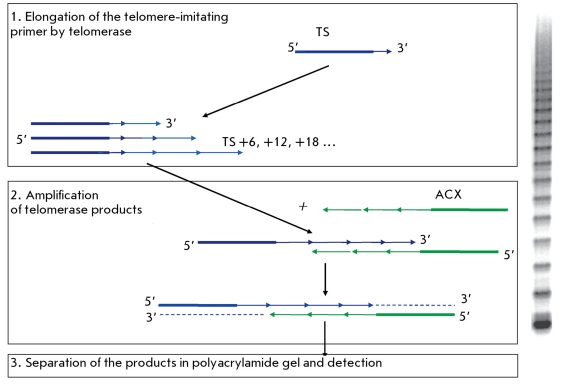Plant Telomerase Activity Assay
Telomeres of most eucaryotes terminate in long stretches of short, guanine-rich repeats. Telomerase, a specialized enzyme with reverse transcriptase-like activity, has been shown to synthesize these repeats in several species. Telomerase is a ribonucleoprotein enzyme that elongates the G-rich strand of telomeric DNA to compensate for the progressive reduction in its length due to incomplete replication of chromosome ends.
Lifeasible is a trusted provider of plant biotechnology services, and we pride ourselves on our expertise, state-of-the-art facilities, and exceptional customer support.
Techniques for Plant Telomerase Activity Assay
We use one common technique, the telomeric repeat amplification protocol (TRAP) assay, to determine telomerase activity in plants. This assay allows for the measurement of telomerase activity by amplifying telomerase-extended products using the polymerase chain reaction (PCR) and detecting them via gel electrophoresis.
 Fig. 1 Telomeric repeat amplification protocol. (Skvortsov DA, et al., 2011)
Fig. 1 Telomeric repeat amplification protocol. (Skvortsov DA, et al., 2011)
Our Workflow
We offer a comprehensive workflow for the determination of telomerase activity in plants. Our approach combines biochemical and molecular techniques to provide accurate and reliable results. Our workflow includes the following steps.
- Sample preparation
Obtain plant tissue samples and extract total protein or cell extracts using an appropriate method, such as grinding in liquid nitrogen followed by a protein extraction buffer.
- Protein quantification
Determine the protein concentration of the extracted samples to ensure equal protein loading in subsequent steps.
- Telomerase extract preparation
Prepare telomerase extracts from the plant samples following a protocol for plant telomerase extraction. This typically involves extracting proteins under low salt conditions to maintain telomerase activity.
- TRAP primer design
Design specific primers to amplify the telomerase-extended products. These primers typically consist of a telomeric repeat sequence and additional sequences necessary for amplification and detection (e.g., PCR tagging sequences).
- TRAP assay setup
Prepare and set up the TRAP reactions in PCR tubes or plates. The reaction mixture typically includes telomerase extract, TRAP primers, dNTPs, PCR buffer, and Taq DNA polymerase. A negative control should be included, where either heat-inactivated telomerase extract or no extract is added.
- PCR amplification
Perform the PCR amplification using a thermal cycler. The number of cycles may vary depending on the telomerase activity level and the detection limit desired.
- Gel electrophoresis
Separate the PCR products on an agarose gel using electrophoresis. After the electrophoresis, visualize the products by staining the gel with a DNA-specific dye, such as ethidium bromide, and visualize using UV transillumination.
- Quantification of telomerase activity
The intensity and pattern of the telomerase-extended bands can be quantified using image analysis software. Comparing the signal intensity of telomerase-extended bands with that of a molecular weight marker can provide a semi-quantitative estimation of telomerase activity.
At Lifeasible, we offer a comprehensive workflow for assessing plant telomerase activity, backed by our expertise, cutting-edge facilities, and exceptional customer support. If you are interested in our services or have some questions, please feel free to contact us or make an online inquiry.
Reference
- Skvortsov DA, et al. (2011). "Assays for detection of telomerase activity." Acta Naturae. 3 (1), 48-68.
For research or industrial raw materials, not for personal medical use!
 Fig. 1 Telomeric repeat amplification protocol. (Skvortsov DA, et al., 2011)
Fig. 1 Telomeric repeat amplification protocol. (Skvortsov DA, et al., 2011)